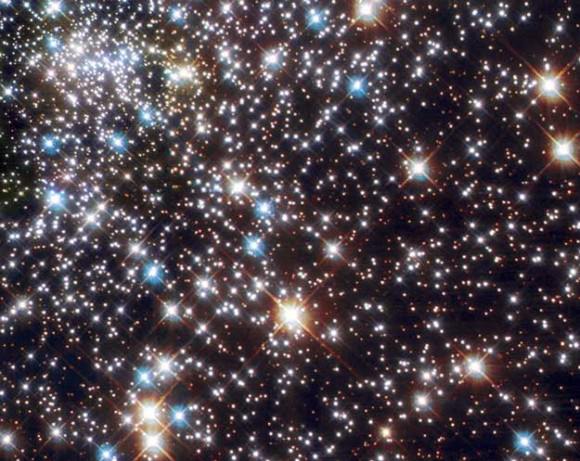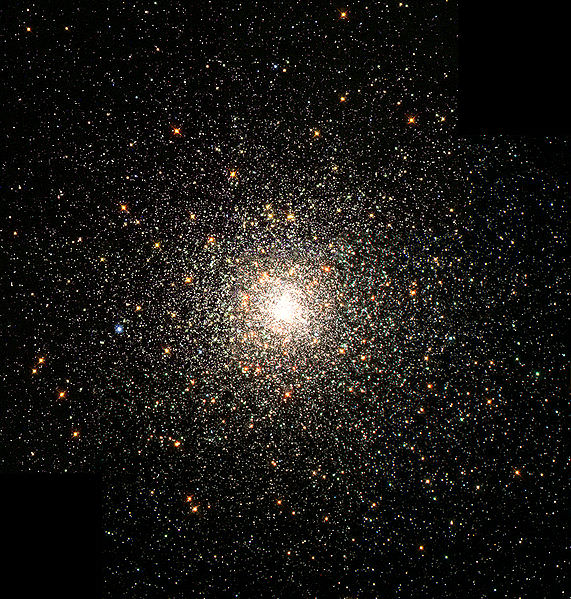[/caption]
Hanging onto the outskirts of our Milky Way galaxy like cockle burs on a shaggy dog’s coat, globular clusters contain over hundreds of thousands of stars. Estimated to be up to ten billion years old, these spherical stellar seed pods are gravitationally bound together and tend to be more dense towards their cores. We’ve long known all the stars contained within a globular cluster to be about the same age and the individual members most likely formed at the same time as the parent galaxy – but what we weren’t expecting was change.
“We thought we understood these clusters very well”, says Dr. Alison Sills, Associate Professor of Physics & Astronomy. She is presenting new findings at this week’s CASCA 2011 meeting in Ontario, Canada. “We taught our students that all the stars in these clusters were formed at the same time, from one giant cloud of gas. And since that time, the individual stars may have evolved and died, but no new stars were born in the cluster.”
In 1953, astronomer Allan Sandage was performing photometry of the stars in the globular cluster M3 when he made an incredible discovery – blue stragglers. No, it’s not a down-his-luck musician waiting for a coin in his instrument case… but a main sequence star more luminous and more blue than stars at the main sequence turn-off point for the cluster. They shouldn’t belong where they are, but with masses two to three times that of the rest of the main sequence cluster stars, blue stragglers seem to be exceptions to the rule. Maybe they are a product of interaction… grappling together… pulling material from one another… and eventually merging.

“Astronomers expect that the stars get too close to each other because of the complicated dance that stars perform in these dense clusters, where thousands of stars are packed into a relatively small space, and each star is moving through this cluster under the influence of the gravity of all the other stars. Somewhat like a traffic system with no stop lights, there are a lot of close encounters and collisions,” explains Sills.
By taking a closer look at globular clusters, the Hubble Space Telescope has given us evidence for two generations of star formation. The first is our accepted rule, but the second generation isn’t like anything else found in our Galaxy. Instead of being created from an earlier generation of expended stars, the second generation in globular clusters appears to have formed from material sloughed off by the first generation of stars. An enigma? You bet.
“Studying the normal stars in clusters was instrumental in allowing astronomers to figure out how stars lived and died”, says Dr. Sills, “but now we can look even further back, to when they were born, by using the oddballs. It pays off to pay attention to the unusual individuals in any population. You never know what they’ll be able to tell you.”
At the CASCA conference, Dr. Sills is presenting her work – a link between these two unusual forms of globular clusters. Blue stragglers and the second generation of stars would appear to have identical properties, including where they are concentrated in the cluster, and that both are.. well.. a little more “blue” than we would expect. She is investigating how the close encounters and collisions could affect the formation of this strange second generation and link the two phenomena we see in these complicated systems.
Real oddballs…
Original story soucre at Physorg.com.


Thats not M80 – M80 is a galaxy in UMa.
Dude, I think that you’re confusing M80 with either M81 or M82.
I wonder what would happen if a globular cluster encountered a giant molecular cloud. Would it absorb the cloud and allow some more star formation to occur?
Back in April 1996, V.G. Surdin of the Sternberg Institute in Moscow wrote an academic Paper on such a cataclysm you can locate it by Googling:
“Globular Clusters and Molecular Clouds: Tidal shocks.”
How might/would a Blue Straggler be influenced by a black hole in the core of a GC?
Odd balls maybe but they certainly are beautiful…
Considering how stars in a GC move, it makes a lot of sense that close encounters could rip material from both stars involved and that new stars could form when enough of this material builds-up. GCs make exceptionally beautiful images, which can rival even those from the magnificent HST, when a DSLR is mounted on an amateur telescope.
Blue and balls… I’m sure there is a US language joke in there somewhere.
In how many globulars is there evidence for a black hole at the center? Is the mutual gravity of the visible stars enough to explain the dynamics? If not is some exotic matter required to explain them? The chance for encounters is enough to explain the second generation? Are ejected stars from the cluster, or stars with high doppler shifts seen?